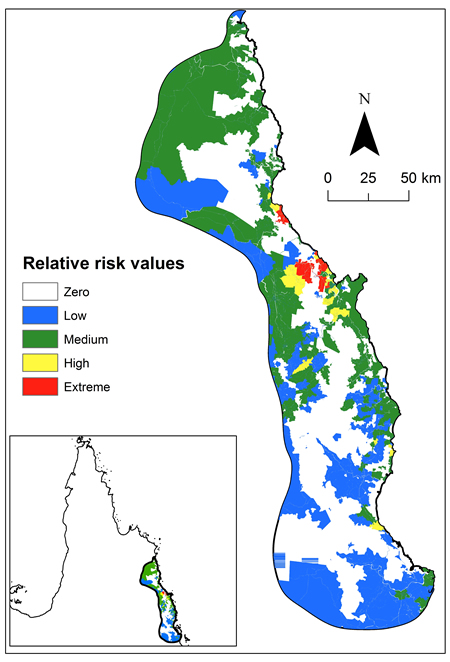Public participation required for the broad-scale eradication of electric ants from Queensland
Electric ants (Wasmannia auropunctata) were first detected in the Cairns area in northern Queensland in May 2006, near to a World Heritage-listed rainforest. This was the first record of an established incursion of this species in Australia, whose native range is South and Central America. The electric ant is considered by the Invasive Species Specialist Group of the International Union for Conservation of Nature to be one of the world’s worst invasive species.Since 2006 the Queensland Department of Agriculture and Fisheries (DAF) has been detecting and removing infestations with the aim of total eradication.
The potted-plant trade is thought to be the pathway of the initial incursion and subsequent movement of electric ants around the Cairns area. Detections of localised infestations have been made by public reporting, sniffer dogs and lure surveys, and surveillance of green-waste disposal sites. The ant is only 1.5 mm long, so people usually only detect it when bitten. The goal of DAF is to have all known infestations eliminated by the end of 2018.
The next step will be to conduct additional surveillance to either detect surviving nests or to be confident that all infestations have been removed. Dean Anderson of Manaaki Whenua was engaged to work with Gary Morton of DAF to address the following three questions:
- What is the most cost-effective allocation of resources to the four available surveillance techniques?
- Given no further detections, when can we can be 95% confident that eradication has been successful?
- What is the approximate cost of surveillance to confirm success?
Dean developed a spatially explicit surveillance-data model to quantify the probability of electric ant eradication given negative surveillance results. The model is applicable only when all known infestations have been destroyed and surveillance returns no detections. The total eradication area was 24 350 km2, of which 14 442 km2 was deemed to be at risk of infestation (Figure). The variation in risk of surviving nests across the control area was incorporated by creating a map that partitioned risk into non-, low, medium, high and extreme risk areas (Figure). The relative risk areas were defined based on land cover and use, and distance to locations of previous infestations. Waterways and forests were considered non-risk areas.

The time and cost to achieve a minimum 0.95 probability of eradication for 24 management strategies was assessed, and the one with the lowest cost was deemed to be the most cost effective. The first strategy reflected the current effort deployed by DAF, in which 30% of the total area was surveyed by the four surveillance methods. The probability of detecting an ant colony in a 100 m2 area using sniffer dogs, lures, public reporting and green-waste surveillance was 0.9, 0.5, 0.12 and 0.03, respectively. While dogs and lures had relatively high probabilities of detection, they were only able to cover approximately 0.02% of the total area, whereas public reporting and green-waste surveillance covered more than 29% of the total area. The current DAF strategy required 7 years of surveillance with a field team of nine individuals, and had a total cost of AUS$ 9.9 million.
 Although sniffer dogs and lure surveys had relatively high probabilities of detecting ants, increasing the area covered by these methods did not decrease the time to successful eradication and increased the overall cost. The most cost-effective strategy retained the current investment in sniffer dog and lure surveys, but increased the number and visiting frequency of green-waste disposal surveillance sites, and also increased community engagement (i.e. seeking and responding to public reports of electric ants). This modification increased the probabilities of detection of public reporting and green-waste surveillance to 0.35 and 0.11, respectively. The annual catchment area covered by green-waste surveillance increased from 100 894 ha (7% of the total area) to 879 219 ha (61% of the total area). Using this strategy, and assuming no further detections, eradication success could be declared in 4 years with a total cost of AUS$6,844 million, or a 31% reduction in total cost of the current strategy.
Although sniffer dogs and lure surveys had relatively high probabilities of detecting ants, increasing the area covered by these methods did not decrease the time to successful eradication and increased the overall cost. The most cost-effective strategy retained the current investment in sniffer dog and lure surveys, but increased the number and visiting frequency of green-waste disposal surveillance sites, and also increased community engagement (i.e. seeking and responding to public reports of electric ants). This modification increased the probabilities of detection of public reporting and green-waste surveillance to 0.35 and 0.11, respectively. The annual catchment area covered by green-waste surveillance increased from 100 894 ha (7% of the total area) to 879 219 ha (61% of the total area). Using this strategy, and assuming no further detections, eradication success could be declared in 4 years with a total cost of AUS$6,844 million, or a 31% reduction in total cost of the current strategy.
This analysis clearly shows that any broad-scale eradication effort will require surveillance techniques that annually cover very large areas. In this case, taking advantage of public participation and non-specialised surveillance techniques (i.e. searching green-waste disposal sites) proved critical for detecting infestations and confirming eradication success. The highly sensitive techniques of sniffer dogs and lure surveys are not to be dismissed, but should be reserved for the surveillance of high- and extreme-risk areas.
Dean Anderson
andersond@landcareresearch.co.nz
Gary Morton (Queensland Department of Agriculture and Fisheries)
